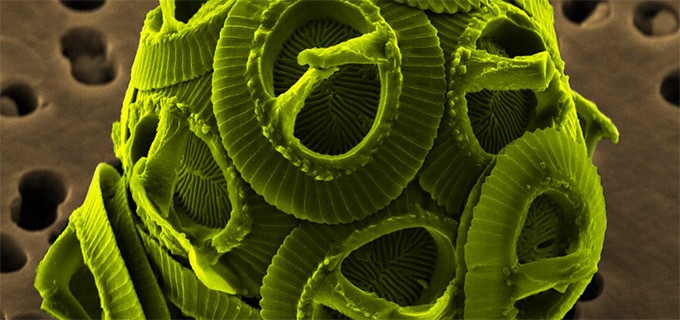AUGUST 15, 2018


According to a new study published onAugust 15iniScience, an open source interdisciplinary journal, ocean microbes may play a key role in atmospheric processes like cloud formation. The research, led byMiri Trainicof theWeizmann Institute of ScienceandHebrew University of Jerusalem, Israel, has shown that in an infected state, one particular phytoplankton may promote cloud formation and potentially alter atmospheric processes. Essentially, the phytoplankton release gases and particles into the atmosphere that provide surfaces, or “seeds,” upon which water vapour can condense to form clouds.
Plankton is a diverse group of single-celled microscopic organisms that drift or float in the sea or freshwater. These tiny organisms are essential for sea life, providing an important source of food for fish, whales, and other large aquatic species. One particular species of phytoplankton,Emiliania huxleyi, seem to ‘explode’ after contracting the aptly namedE. huxleyivirus.
The viral infection causesE. huxleyito burst thereby shedding many of their coccoliths ― plates of calcium carbonate formed byE. huxleyiand arranged around the coccosphere. In other words, phytoplanktons infected with the virus rapidly emit airborne particles that once released join the ranks of a class of marine emissions, including sea salts, referred to as seaspray aerosols. Seaspray aerosols are present in 70% of the atmosphere and can serve as cloud condensation nuclei ― also known as seeds ― provide surfaces for critical chemical reactions, and reflect solar radiation away from the earth’s surface to reduce global warming. This type of coccolith shedding occurs regularly but the amount of shedding significantly increases in the presence of the viral infection.
To investigate the extent of this shedding phenomenon and the potential impact on the cloud formation process, researchers set up a model system in the laboratory. Cultures ofE. huxleyiin seawater were exposed to the virus and within one day the infected plankton quickly lost 25% more coccoliths than uninfected controls, and the concentration of coccoliths in the seawater continued to increase over the next week. Scientists then used a bubbling system (air pumped through a tank) to measure how many coccoliths were turned into aerosols. Similarly, coccolith concentrations in the aerosols of infected samples were of an order of magnitude higher than the controls.
The size and shape of coccoliths with their large plate-like structures is part of the reason they are so readily airborne. This means they settle out of the atmosphere around 25 times slower than sea salt particles of the same dimensions. Staying in the atmosphere for longer provides more opportunity for them to facilitate chemical reactions such as those involved in cloud formation. Moreover, a greater number of particles that are larger in size will be a lot more reflective and could potentially have a strong influence on cloud properties. They may also potentially transform into calcium nitrate particles in the atmosphere, thereby creating large cloud condensation nuclei. The next step will be to test this out on a larger scale.
The findings confirm a potential link between this particular species of phytoplankton and climate. Increased coccolith shedding may play an important role in regulating the atmospheric climate by contributing to sea spray aerosols, and highlights an important connection between the many different components and species in our ecosystem.
Publication:Trainic, M. et al. Infection Dynamics of a Bloom-Forming Alga and Its Virus Determine Airborne Coccolith Emission from Seawater.iScience(2018). DOI: 10.1016/j.isci.2018.07.017